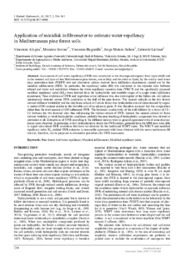Por favor, use este identificador para citar o enlazar este ítem:
https://hdl.handle.net/11000/5255
Application of minidisk infiltrometer to estimate water repellency in Mediterranean pine forest soils
Título :
Application of minidisk infiltrometer to estimate water repellency in Mediterranean pine forest soils |
Autor :
Alagna, Vincenzo
Iovino, Massimo
Bagarello, Vincenzo
Mataix-Solera, Jorge 
Lichner, Ľubomír |
Departamento:
Departamentos de la UMH::Agroquímica y Medio Ambiente |
Fecha de publicación:
2017 |
URI :
http://hdl.handle.net/11000/5255 |
Resumen :
Assessment of soil water repellency (SWR) was conducted in the decomposed organic floor layer (duff) and
in the mineral soil layer of two Mediterranean pine forests, one in Italy and the other in Spain, by the widely-used water
drop penetration time (WDPT) test and alternative indices derived from infiltration experiments carried out by the
minidisk infiltrometer (MDI). In particular, the repellency index (RI) was calculated as the adjusted ratio between
ethanol and water soil sorptivities whereas the water repellency cessation time (WRCT) and the specifically proposed
modified repellency index (RIm) were derived from the hydrophobic and wettable stages of a single water infiltration
experiment. Time evolution of SWR and vegetation cover influence was also investigated at the Italian site. All indices
unanimously detected severe SWR conditions in the duff of the pine forests. The mineral subsoils in the two forests
showed different wettability and the clay-loam subsoil at Ciavolo forest was hydrophobic even if characterized by organic
matter (OM) content similar to the wettable soil of an adjacent glade. It was therefore assumed that the composition
rather than the total amount of OM influenced SWR. The hydraulic conductivity of the duff differed by a factor of 3.8–
5.8 between the two forested sites thus influencing the vertical extent of SWR. Indeed, the mineral subsoil of Javea
showed wettable or weak hydrophobic conditions probably because leaching of hydrophobic compounds was slowed or
prevented at all. Estimations of SWR according to the different indices were in general agreement even if some discrepancies
were observed. In particular, at low hydrophobicity levels the SWR indices gathered from the MDI tests were able
to signal sub-critical SWR conditions that were not detected by the traditional WDPT index. The WRCT and modified
repellency index RIm yielded SWR estimates in reasonable agreement with those obtained with the more cumbersome RI
test and, therefore, can be proposed as alternative procedures for SWR assessment
|
Palabras clave/Materias:
Pine forest
Soil water repellency
Minidisk infiltrometer
Modified repellency index |
Área de conocimiento :
Agricultura. Agronomía. Maquinaria agrícola. Suelos. Edafología agrícola |
Tipo de documento :
info:eu-repo/semantics/article |
Derechos de acceso:
info:eu-repo/semantics/openAccess |
DOI :
http://dx.doi.org/0.1515/johh-2017-0009 |
Aparece en las colecciones:
Artículos Agroquímica y Medio Ambiente
|
 La licencia se describe como: Atribución-NonComercial-NoDerivada 4.0 Internacional.
La licencia se describe como: Atribución-NonComercial-NoDerivada 4.0 Internacional.
 La licencia se describe como: Atribución-NonComercial-NoDerivada 4.0 Internacional.
La licencia se describe como: Atribución-NonComercial-NoDerivada 4.0 Internacional.
.png)
